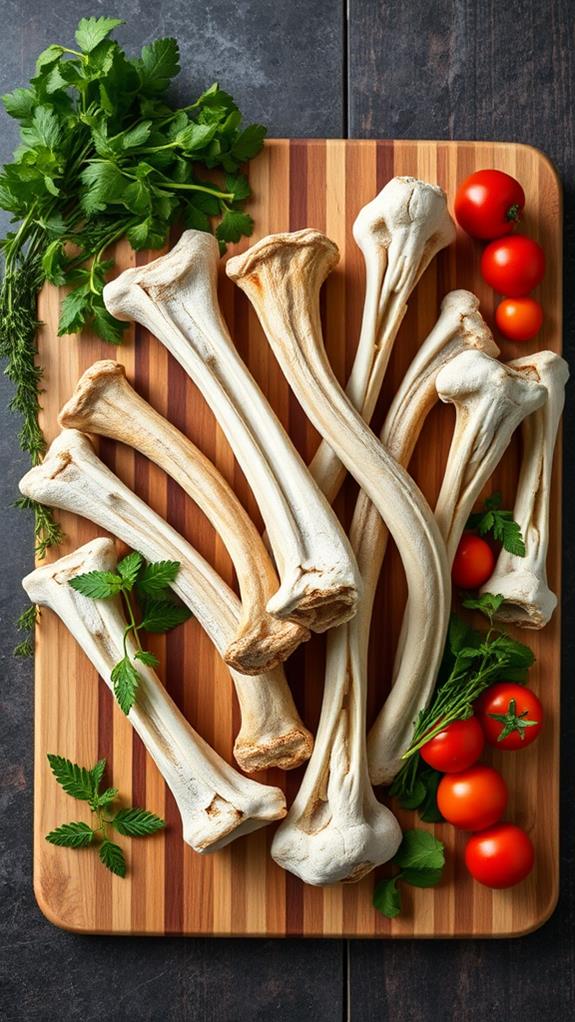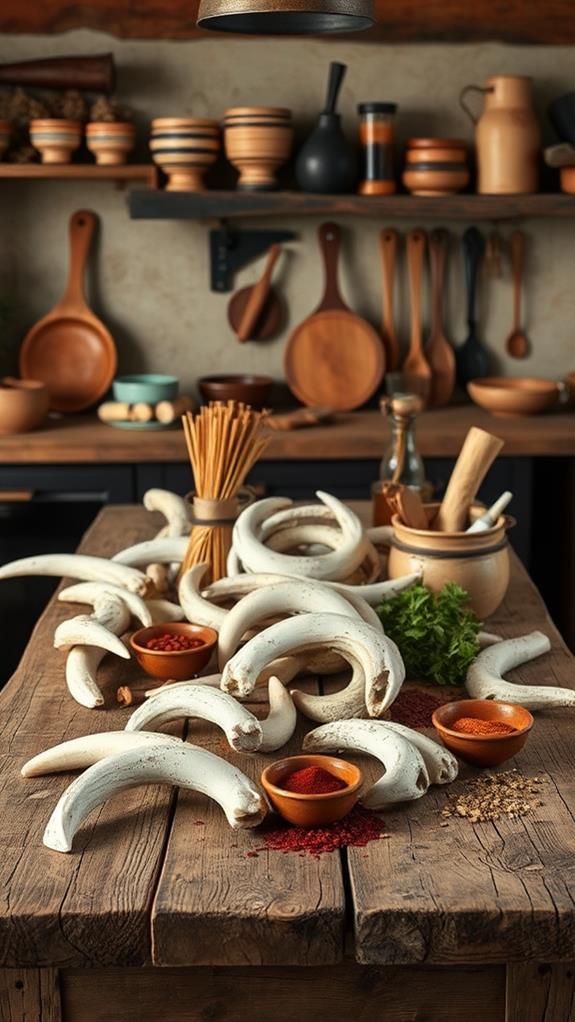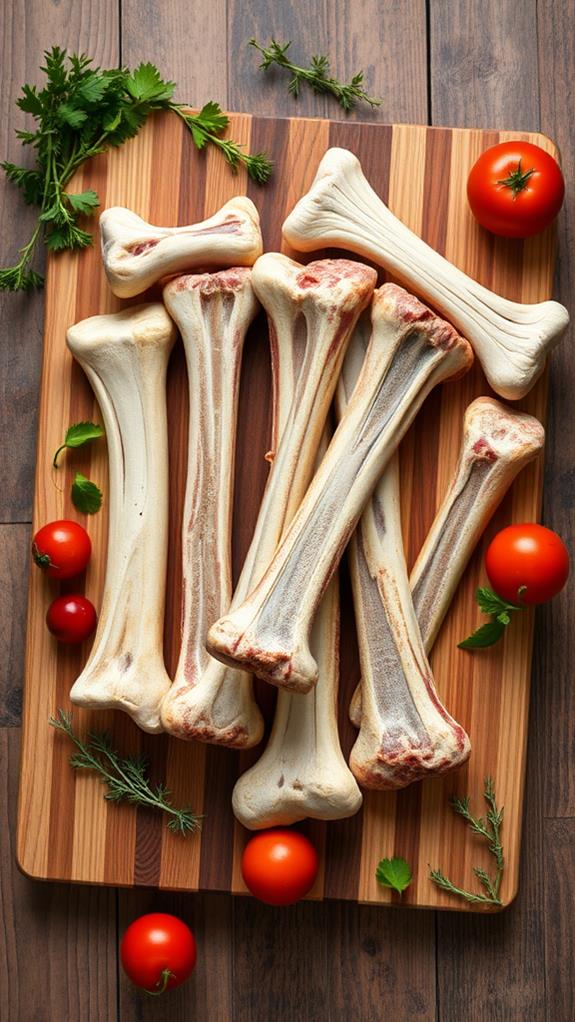Is It Safe to Eat Bones
Eating bones isn't generally safe for humans due to several risks. While bones contain valuable nutrients like calcium and collagen, they can pose serious health hazards. You might face choking risks, digestive blockages, or tooth damage from chewing on hard bones. Sharp bone fragments can injure your digestive tract, leading to complications. However, some cultures have traditions involving bone consumption, and bone broth is considered beneficial for health. If you're interested in incorporating bones into your diet, it's essential to prepare them safely, such as simmering for extended periods to extract nutrients. Understanding the potential risks and proper preparation methods can help you make informed decisions about bone consumption.
This post may contain affiliate links. If you make a purchase through these links, I may earn a commission at no additional cost to you. Additionally, portions of this post may be generated using artificial intelligence (AI) technology. While we strive for accuracy, please be aware that AI-generated content may not always be perfect and should be fact-checked when necessary.
The Spatula Scoops
- Bones provide valuable nutrients but pose risks of choking and digestive blockages if consumed whole.
- Chewing on bones can damage teeth and gums, potentially leading to dental issues and infections.
- Raw or improperly prepared bones may harbor harmful bacteria, increasing the risk of foodborne illness.
- Bone broth and finely ground bone powder are safer alternatives for consuming bone nutrients.
- Cultural practices and traditions influence bone consumption, but safety precautions should still be observed.
Nutritional Value of Bones

Despite their often-overlooked status, bones contain a wealth of nutrients that can benefit your health. They're rich in minerals like calcium, phosphorus, and magnesium, which are essential for maintaining strong bones and teeth. You'll also find collagen, a protein that supports joint health and skin elasticity, in abundance. Similar to hand-picked whole cloves, bones offer a range of health benefits and culinary applications. Their natural properties can enhance various dishes and contribute to overall well-being.
Bone marrow, the spongy tissue inside bones, is particularly nutritious. It's packed with vitamins A and K2, as well as omega-3 fatty acids. These nutrients play fundamental roles in immune function, blood clotting, and heart health. Additionally, bone broth, made by simmering bones for extended periods, extracts these nutrients in an easily digestible form.
When you consume bones or bone-derived products, you're also getting glycine and proline, amino acids that support detoxification and gut health. However, it must be underscored that the bioavailability of these nutrients can vary depending on the preparation method. For optimal nutrient absorption, you'll want to consume bones that have been cooked or processed in some way, such as in broths or stews. This process breaks down the bone structure, making the nutrients more accessible to your body.
Potential Health Risks
While bones can offer nutritional benefits, you should be aware of several potential health risks associated with consuming them. Choking and digestive blockages are serious concerns, especially with small or sharp bone fragments that can lodge in your throat or intestines. Similar to improperly stored chicken, bones may harbor harmful bacteria if not handled correctly, increasing your risk of foodborne illness. You're also at risk of damaging your teeth and gums when chewing on hard bones, and improperly handled or stored bones may harbor harmful bacteria, increasing your chances of foodborne illness.
Choking and Digestive Blockages
One of the most serious risks associated with eating bones is the potential for choking and digestive blockages. When you consume bones, especially smaller or splintered ones, they can become lodged in your throat or esophagus, causing a choking hazard. Even if you manage to swallow them, these bone fragments can create obstructions in your digestive tract, leading to severe complications.
The dangers of bone consumption include:
- Esophageal tears or perforations
- Intestinal blockages requiring surgical intervention
- Internal bleeding from sharp bone edges
- Damage to the stomach lining or intestinal walls
You should be particularly cautious with poultry bones, as they're prone to splintering. Larger bones from mammals can also pose risks if not properly chewed or if swallowed in large pieces. Your digestive system isn't designed to break down bones effectively, which means they can cause problems throughout your gastrointestinal tract. If you experience pain, difficulty swallowing, or bloody stools after consuming bones, seek immediate medical attention. Remember, while some cultures traditionally consume certain types of bones, it's generally safer to avoid eating them altogether to prevent these potentially life-threatening complications.
Tooth and Gum Damage
Chomping down on bones can wreak havoc on your teeth and gums. When you bite into hard bones, you're risking damage to your dental enamel, the protective outer layer of your teeth. This can lead to chips, cracks, or even fractures in your teeth, potentially requiring expensive dental work.
Moreover, the sharp edges of bones can cut or scratch your gums, causing inflammation and bleeding. These injuries create entry points for bacteria, increasing your risk of gum disease and infections. If you have existing dental work like crowns, bridges, or veneers, biting on bones can dislodge or damage these restorations.
The repeated stress of chewing on hard bones can also contribute to temporomandibular joint (TMJ) disorders, affecting the joint that connects your jaw to your skull. This can result in jaw pain, difficulty chewing, and headaches. Additionally, bone fragments can get lodged between your teeth or under your gums, leading to discomfort and potential infections if not properly removed. To protect your oral health, it's best to avoid chewing on bones and opt for softer, teeth-friendly foods instead.
Foodborne Illness Risks
Beyond the risks to your dental health, eating bones can expose you to various foodborne illnesses. Raw or undercooked bones may harbor harmful bacteria like Salmonella or E. coli, which can lead to severe gastrointestinal issues. Even if you're consuming cooked bones, there's still a risk of contamination during handling or storage.
When considering eating bones, be aware of these potential health risks:
- Bacterial infections from raw or improperly cooked bones
- Parasitic infections, especially in wild game bones
- Toxins that may accumulate in bone marrow
- Choking hazards or internal injuries from sharp bone fragments
It's paramount to understand that bones aren't typically processed with human consumption in mind. They may contain residual chemicals or medications used in animal husbandry. Additionally, bones can absorb environmental pollutants over time, potentially exposing you to harmful substances.
If you're determined to consume bones, make certain they're from a reputable source and properly prepared. However, it's generally safer to obtain nutrients traditionally associated with bone consumption, such as calcium and collagen, from other dietary sources or supplements. Always prioritize your health and consult with a healthcare professional before incorporating unconventional foods into your diet.
Cultural Practices and Traditions

Throughout history, you'll find that many cultures have incorporated bone consumption into their diets and traditions. The Cherokee, for example, emphasize sustainability and respect for nature in their traditional cuisine, which includes the use of various plant and animal parts. Their matrilineal clan system also influences food practices and cultural traditions. In some religious and spiritual practices, bones hold significant symbolic meaning, often representing essential, fundamental, or core connections to ancestors. Today, you can still observe modern culinary traditions that embrace bone-based dishes, such as bone broth or marrow-based recipes, which continue to be popular in various cuisines worldwide.
Historical Bone Consumption Practices
Bone broth and marrow have been staples in many cultures for centuries. You'll find that our ancestors didn't let any part of an animal go to waste, including the bones. In ancient times, people would crack open bones to access the nutrient-rich marrow inside, a practice that's still common in many parts of the world today.
Throughout history, various cultures have incorporated bone consumption in different ways:
- Native American tribes often used bone marrow as a source of essential fats and nutrients
- Ancient Romans considered bone marrow a delicacy and used it in elaborate dishes
- Traditional Chinese medicine has long utilized bone broth for its perceived health benefits
- Nordic cultures have a history of fermenting fish bones to create a vitamin-rich paste
You might be surprised to learn that bone consumption wasn't limited to food. In some ancient societies, bones were ground into powder and used medicinally. This practice, known as "osteophagy," was believed to offer healing properties for various ailments. While modern science doesn't support many of these claims, the historical significance of bone consumption is undeniable. Today, bone broth has experienced a resurgence in popularity, with many people incorporating it into their diets for its potential nutritional benefits.
Religious and Spiritual Significance
While bone consumption has played a significant role in nutrition throughout history, it's also held deep religious and spiritual meaning for many cultures. You'll find that bones often symbolize life, death, and resurrection in various belief systems. For instance, in some Native American traditions, you might see ceremonial use of bone whistles or flutes, believed to connect the physical and supernatural realms.
In Tibetan Buddhism, you'll encounter the practice of using human bones to craft ritual objects like kangling (thighbone trumpets) and kapala (skull cups). These items serve as powerful reminders of impermanence and are utilized in meditation practices. Christianity, too, has its bone-related traditions, with the veneration of saints' relics, often including bone fragments, being a common practice in some denominations.
In many African spiritual practices, you'll discover that bones play an indispensable role in divination rituals. Bone throwing, or osteomancy, is a method where shamans interpret patterns formed by tossed bones to gain insights into the future or communicate with ancestors. These practices underscore the enduring significance of bones in religious and spiritual contexts across cultures.
Modern Culinary Bone Traditions
Many cultures around the world have embraced bone-based culinary traditions that persist to this day. You'll find bone broth, a nutrient-rich soup made by simmering bones, gaining popularity in health-conscious circles. In East Asian cuisines, you'll encounter dishes like Korean seolleongtang or Japanese tonkotsu ramen, which rely on long-simmered bone broths for their rich flavors.
Bone marrow, once considered a delicacy, is making a comeback in fine dining establishments. You'll see it roasted and spread on toast or used to add depth to sauces. Some adventurous eaters even enjoy bone-in meat dishes, where they can gnaw on the bones for extra flavor.
Modern culinary bone traditions include:
- Bone broth as a health supplement
- Bone marrow as a gourmet ingredient
- Whole animal cooking, utilizing bones for flavor
- Bone-in meat cuts for enhanced taste and presentation
These traditions not only honor age-old practices but also align with contemporary trends in sustainable eating. By using every part of the animal, including bones, you're participating in a more environmentally conscious approach to food consumption. This practice also maximizes the nutritional benefits you can derive from your meals.
Bone Broth and Its Benefits
A growing trend in health and culinary circles, bone broth has gained popularity for its potential benefits. You'll find it's made by simmering animal bones and connective tissues for extended periods, often with vegetables and herbs. This process extracts nutrients, minerals, and collagen from the bones, creating a flavorful and nutrient-dense liquid.
Many proponents claim bone broth offers various health benefits, including:
| Benefit | Description |
|---|---|
| Gut health | May support digestive system function |
| Joint support | Collagen might help reduce joint pain |
| Skin health | Collagen could improve skin elasticity |
| Immune boost | Amino acids may support immune function |
While scientific evidence is limited, bone broth's nutritional profile suggests it can be a healthy addition to your diet. It's rich in protein, minerals like calcium and magnesium, and amino acids such as glycine and proline. You can make bone broth at home or purchase it pre-made from health food stores and some supermarkets.
When incorporating bone broth into your diet, start with small amounts and gradually increase consumption. It's versatile and can be used as a base for soups, sauces, or simply enjoyed on its own as a warm beverage.
Edible Bones in Pet Diets

Nutrition plays a pivotal role in pet health, and edible bones can be a valuable component of some animals' diets. When considering bones for your pet, it's indispensable to understand which types are safe and beneficial. Raw bones, particularly from chicken or turkey, are often recommended for dogs and cats due to their soft, pliable nature.
These edible bones offer several benefits for your pets:
- Dental health: Chewing on bones helps remove plaque and tartar
- Mental stimulation: Gnawing provides entertainment and reduces boredom
- Nutritional value: Bones contain calcium, phosphorus, and other minerals
- Digestive aid: Bone marrow can support gut health
However, you shouldn't give your pet just any bone. Cooked bones are dangerous, as they can splinter and cause internal injuries. Always supervise your pet when they're chewing on bones, and remove any small pieces that could pose a choking hazard. It's quintessential to choose appropriately sized bones for your pet's breed and size. Consult with your veterinarian before introducing bones into your pet's diet, as they can provide tailored advice based on your animal's specific needs and health conditions.
Preparing and Consuming Bones Safely
When considering the consumption of bones, how can you guarantee safety? First, you'll need to ensure proper preparation. Always cook bones thoroughly to eliminate harmful bacteria. If you're consuming bone broth, simmer it for several hours to extract nutrients and soften the bones. For whole bones, opt for those from reputable sources and avoid feeding them to young children or elderly individuals who may have difficulty chewing.
You should never consume cooked bones whole, as they can splinter and cause internal injuries. Instead, grind them into a fine powder or extract their nutrients through prolonged cooking. If you're incorporating bone meal into your diet, choose a high-quality, food-grade product.
It's imperative to be aware of potential choking hazards and digestive issues. Start with small amounts and gradually increase your intake to allow your body to adapt. Always consult with a healthcare professional before making significant changes to your diet, especially if you have pre-existing conditions or are taking medications that may interact with bone-derived nutrients.
Frequently Asked Questions
Can Humans Digest Bones Completely?
You can't fully digest bones. Your digestive system isn't equipped to break down the hard, mineral-rich structure of bones completely. While your stomach acid can soften and partially dissolve small bone fragments, larger pieces will pass through your system mostly intact. This is why you shouldn't swallow bones, as they can potentially cause blockages or injuries in your digestive tract. Some animals, like hyenas, have specialized digestive systems that can process bones, but humans don't have this ability.
Are There Any Bones That Are Toxic to Humans?
Like a wolf in sheep's clothing, some bones can be deceptively dangerous. While most bones aren't toxic, you should be cautious. Pufferfish bones contain tetrodotoxin, a potent neurotoxin. You'll also want to avoid bones from animals that have consumed toxic plants or those treated with certain medications. Additionally, bones from animals exposed to environmental toxins can be harmful. It's always best to consult with a healthcare professional or nutritionist before consuming any unusual food items, including bones.
How Do Bones Compare Nutritionally to Other Calcium-Rich Foods?
You'll find that bones, while rich in calcium, aren't as easily digestible as other calcium-rich foods. They're high in minerals but lack the balanced nutrition of alternatives like dairy products, leafy greens, or fortified foods. These options offer more readily absorbable calcium alongside other essential nutrients. While bone broth can provide some benefits, it's generally more efficient to get your calcium from diverse dietary sources that your body can process more effectively.
Can Eating Bones Help Strengthen Human Teeth?
While you might think crunching on bones could strengthen your teeth, it's not that simple. Eating bones can provide calcium, which is essential for dental health, but it's not a direct path to stronger teeth. Your body doesn't absorb calcium from bones as efficiently as from other sources. Additionally, chewing on hard bones can actually damage your teeth. Instead, focus on a balanced diet rich in calcium and vitamin D, and maintain good oral hygiene for ideal dental health.
Are There Any Religious or Cultural Taboos Against Eating Bones?
You'll find that many cultures and religions have taboos against eating bones. For example, in Judaism, consuming bone marrow from non-kosher animals is forbidden. Some Buddhist traditions discourage eating bones, believing it disrespects the animal's life. In Western cultures, there's often a social stigma against bone consumption. However, other cultures, like some Asian and African societies, consider bone broth and marrow delicacies. It's important to respect these diverse perspectives when discussing or practicing bone consumption.
Conclusion
You've learned that while bones can offer nutritional benefits, they're not without risks. Remember, it's vital/essential/paramount to prepare and consume them safely. Consider the case of a dog owner who regularly gave her pet cooked chicken bones, only to face a costly emergency vet visit when one splintered in the dog's throat. Whether you're exploring bone broth or cultural practices involving bone consumption, always prioritize safety and consult experts when in doubt. Ultimately, the decision to eat bones should be made with caution and informed consideration.





